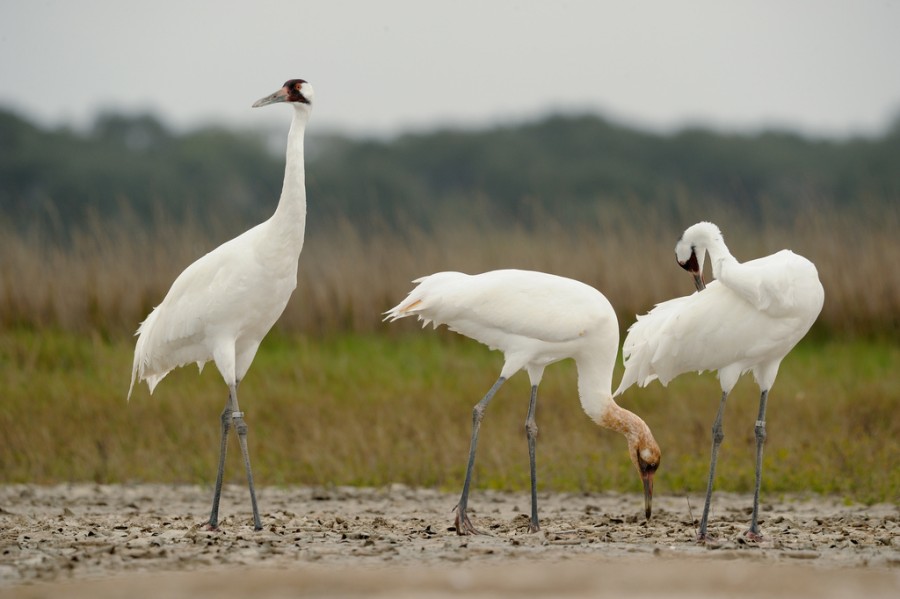Spotlight: The Man Who Bonded With A Whooping Crane And Helped Save The Species
By WBEZ Staff

Spotlight: The Man Who Bonded With A Whooping Crane And Helped Save The Species
By WBEZ StaffDr. George Archibald has a special relationship with cranes.
He co-founded the International Crane Foundation with a college friend after he learned how endangered the birds were. He has since dedicated his life to saving them.
Decades ago, a whooping crane named Tex even “imprinted” on him.
“From 1976 to 1982, I danced most springs with a female whooping crane that unfortunately was raised at a zoo — San Antonio Zoo,” Archibald said on Worldview. “She became imprinted on people, so it ignored cranes but loved me.
“The government allowed me to work with this bird, and after six years of work, we finally — through artificial insemination — procured an egg that hatched and produced a beautiful young male crane called Gee Whiz, who now has produced 24 offspring and has 95 grandchildren.”
More than 40 years after he started his conservation efforts, the once critically endangered whooping cranes — with only 15 left in the world in the 1940s — now have a population of just over 600, according to the U.S. Fish and Wildlife Service.
Archibald would go on to talk about Tex on The Tonight Show with Johnny Carson. On Thursday, he joined Worldview’s Jerome McDonnell to talk about his life’s work. Below are highlights from the conversation.
On Tex, the whooping crane who imprinted on Archibald
George Archibald: From 1976 to 1982, I danced most springs with a female whooping crane that unfortunately was raised at a zoo, San Antonio Zoo, by a very caring director of the zoo who was afraid it would die if left with its parents, as other crane chicks had done at that zoo. And those parents were alive when there were only 28 whooping cranes in the world. And she was the only offspring that survived, but she became imprinted on people, so it ignored cranes but loved me. The government allowed me to work with this bird, and after six years of work, we finally — through artificial insemination — procured an egg that hatched and produced a beautiful young male crane called Gee Whiz, who now has produced 24 offspring and has 95 grandchildren. And some of them have been reintroduced into the wild. So through this crazy dance that I had to do with Tex, we now have those genes flying around in the skies of Wisconsin and Louisiana.
On his appearance on The Tonight Show with Johnny Carson
Archibald: The day before I went on the Johnny Carson show I went down to visit Tex, who was then molting her flight feathers, but she still wanted to dance. I said goodbye to her and went out to California. That night, a pack of raccoons attacked the Crane Foundation, and the only bird they killed was Tex. And all they found in the morning was a beak. She was gone. So I was about to go on the show that day at 5:30 in the afternoon. At ten o’clock in the morning, I got the call from the Crane Foundation that Tex had been destroyed. And of course, I am a Christian and I realize this timing is sort of supernatural and meant to be. So I was sort of optimistic about the whole thing, that I could tell the story about Tex as a memorial to Tex, so that evening I told the world — or 22 million of them — our story about this dance with the whooping crane and the production of Gee Whiz, who held the genes. And has subsequently become one of our best breeders.
On why cranes are important
Archibald: Cranes are ancient birds that have been on our planet for millions of years and they are one of the most endangered group of birds in the world today. From my graduate studies of cranes at Cornell University, I became very concerned about their welfare, especially in Africa and Asia, so I decided to do something to help cranes. Hence, my life has been dedicated to the growth of an organization called the International Crane Foundation and we travel the world, working with local communities and governments and whatever to protect these birds. Why are they special? They’re man-sized, they’re huge birds, they’re monogamous, they have an incredible communication system, both vocally and visually with their displays. They dance, they duet, they defend huge wetland territories where they lavish care on their eggs, and their chicks and they’re young. And they only raise one bird every few years on the average. They live for a long time — they’ve lived to be over eighty years old in captivity, and in the wild it’s around 30 if they’re lucky, you know, they don’t have health care in the wild. They’re just absolutely fascinating creatures that captivated my interest.
On his relationship with the Japanese royal family
Archibald: We were honored in 1998 to have the visit of Princess Sayako, the daughter of the Emperor of Japan, and we had an entourage of 42 flying on a private plane to Madison, Wisconsin. We had the F.B.I. there to protect them, and we had a great wonderful time. And I had met the current Emperor when he was not the Emperor back in 1972 during my campaign and I have had this long history with in frequent interactions with the royal family. Princess Sayako is absolutely terrific, because she is a professional ornithologist. It’s been great fun to know them and of course they carry great sway in the Japanese society when they endorse an interest in something.
This interview has been edited for brevity and clarity. It was produced and edited by Vera Tan. Click the ‘play’ button to listen to the entire interview.
